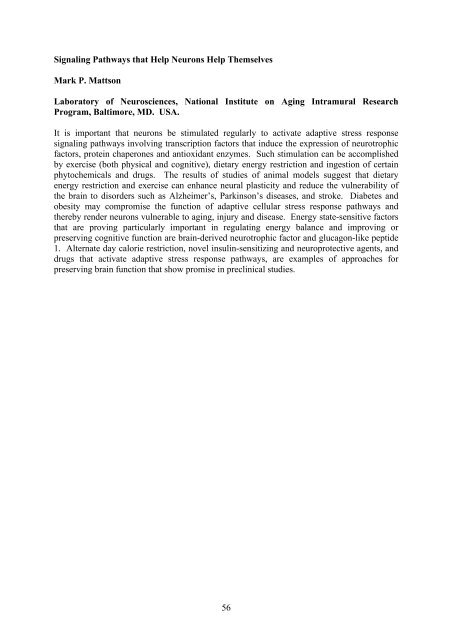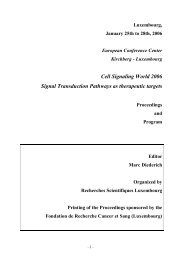Abstract book (download .pdf file) - Redox and Inflammation ...
Abstract book (download .pdf file) - Redox and Inflammation ...
Abstract book (download .pdf file) - Redox and Inflammation ...
You also want an ePaper? Increase the reach of your titles
YUMPU automatically turns print PDFs into web optimized ePapers that Google loves.
Signaling Pathways that Help Neurons Help Themselves<br />
Mark P. Mattson<br />
Laboratory of Neurosciences, National Institute on Aging Intramural Research<br />
Program, Baltimore, MD. USA.<br />
It is important that neurons be stimulated regularly to activate adaptive stress response<br />
signaling pathways involving transcription factors that induce the expression of neurotrophic<br />
factors, protein chaperones <strong>and</strong> antioxidant enzymes. Such stimulation can be accomplished<br />
by exercise (both physical <strong>and</strong> cognitive), dietary energy restriction <strong>and</strong> ingestion of certain<br />
phytochemicals <strong>and</strong> drugs. The results of studies of animal models suggest that dietary<br />
energy restriction <strong>and</strong> exercise can enhance neural plasticity <strong>and</strong> reduce the vulnerability of<br />
the brain to disorders such as Alzheimer’s, Parkinson’s diseases, <strong>and</strong> stroke. Diabetes <strong>and</strong><br />
obesity may compromise the function of adaptive cellular stress response pathways <strong>and</strong><br />
thereby render neurons vulnerable to aging, injury <strong>and</strong> disease. Energy state-sensitive factors<br />
that are proving particularly important in regulating energy balance <strong>and</strong> improving or<br />
preserving cognitive function are brain-derived neurotrophic factor <strong>and</strong> glucagon-like peptide<br />
1. Alternate day calorie restriction, novel insulin-sensitizing <strong>and</strong> neuroprotective agents, <strong>and</strong><br />
drugs that activate adaptive stress response pathways, are examples of approaches for<br />
preserving brain function that show promise in preclinical studies.<br />
56




